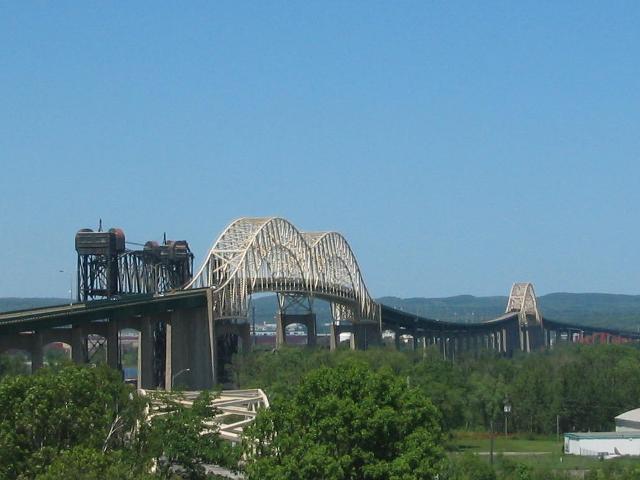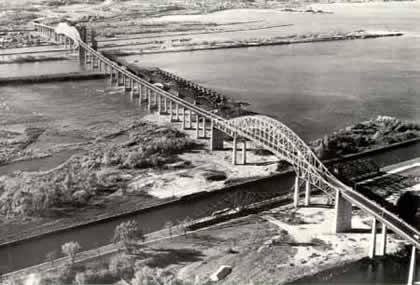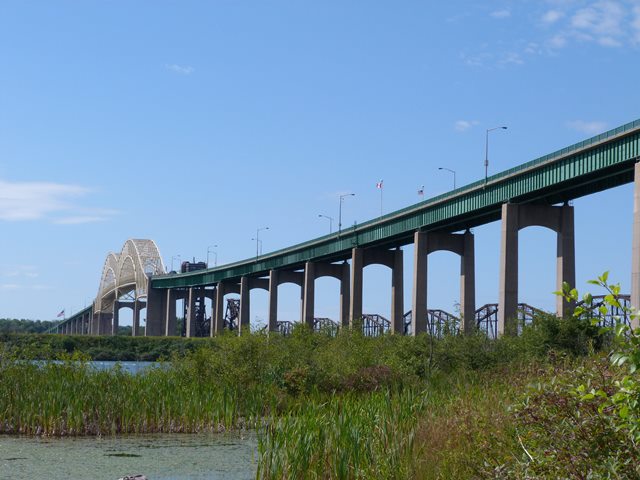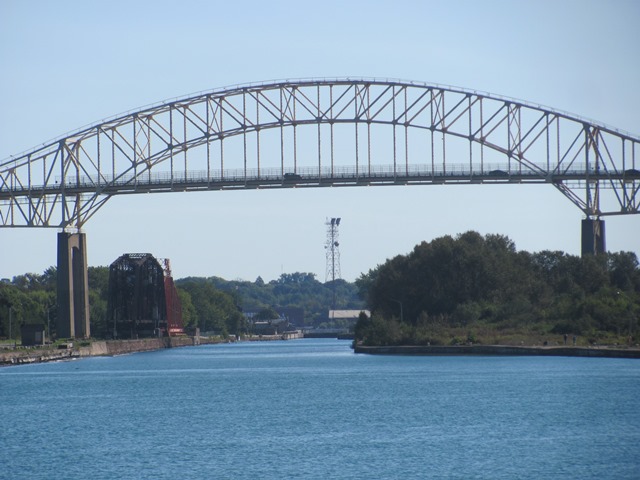We Recommend:
Bach Steel - Experts at historic truss bridge restoration.
BridgeHunter.com Phase 1 is released to the public! - Visit Now
International Bridge
Sault Ste. Marie International Bridge

Primary Photographer(s): Nathan Holth
Bridge Documented: May 16, 2006, June 25, 2011, and September 6, 2014
I-75 / TC-17B Over St. Marys River and Associated Canal System
Sault Ste. Marie: Chippewa County, Michigan and Algoma District, Ontario: Canada and United States
Metal Cantilever (Arch and Suspended Deck) Bolt-Connected Warren Through Truss, Fixed and Approach Spans: Metal 8 Panel Bolt-Connected Warren Deck Truss, Fixed
1962 By Builder/Contractor: Bethlehem Steel Company of Bethlehem, Pennsylvania and Raff and Dexter of Lansing, Michigan and Engineer/Design: Steinman, Boynton, Gronquist and London of New York, New York
Not Available or Not Applicable
430.0 Feet (131.1 Meters)
9,280.6 Feet (2828.7 Meters)
28 Feet (8.53 Meters)
7 Main Span(s) and 56 Approach Span(s)
17117034000B010

View Information About HSR Ratings
Bridge Documentation
View Archived National Bridge Inventory Report - Has Additional Details and Evaluation
View Michigan Department of Transportation Official Website For This Bridge
View The International Bridge Administration Website
Although perhaps the most well-known and visible bridge in Sault Ste Marie, from a historical perspective, this is one of the younger historic bridges in the area, when compared to the International Railroad Bridge, and the Emergency Swing Span, and the Ashmun Street Bridge
This bridge is a complex structure. The minor spans are all deck plate girder spans. There is a deck truss span over the Power Canal on the Michigan side. The continuous truss unit over the U.S. canals is a four span through truss with two arch-shaped spans featuring suspended deck, giving it an arch-like shape. This style of continuous truss unit usually only has a single arch-shaped suspended deck span, making this part of the bridge extremely rare. The span over the Ontario canal is another continuous truss unit with suspended deck, but this unit is of traditional arrangement with only a single arch-shaped suspended deck truss span. The bridge is noted for its sag in between these two through truss units, which was done because under-bridge clearance was not a concern at that part and so to reduce costs, the piers were built with a lower height there. The International Bridge lacks any v-lacing or lattice, and all connections are bolted. There are rivets on the built-up beams however. The concrete piers are tall and impressive, but feature minimal aesthetics, especially when compared to a bridge like the Blue Water Bridge.
Information and Findings From Michigan Historic Bridge InventoryNarrative Description
This is one of Michigan's five monumental bridges. The twin cities of Sault Ste. Marie in Michigan and Ontario were linked by a railroad bridge in 1887, but automobile traffic between the cities was carried by ferry until this bridge was opened in 1962. An International Bridge Authority was created by the Michigan State Legislature and passed before construction was begun. It was designed by the firm of Steinman, Boyton, Gronquist, and London of New York and cost twenty million dollars. This bridge was an ambitious project because it crossed two navigation canals and the St. Mary's River.Overall, the bridge is 2.76 miles long, including approaches, and provides a two lane roadway 28 feet wide. The Main spans had to be erected without the use of falsework so as not to obstruct traffic through the American and Canadian Locks. This was done through the balanced addition of steel structural members on the main spans. |
![]()
Photo Galleries and Videos: International Bridge
2014 Bridge Photo-Documentation
Original / Full Size PhotosA collection of overview and detail photos. This gallery offers photos in the highest available resolution and file size in a touch-friendly popup viewer.
Alternatively, Browse Without Using Viewer
![]()
2014 Bridge Photo-Documentation
Mobile Optimized PhotosA collection of overview and detail photos. This gallery features data-friendly, fast-loading photos in a touch-friendly popup viewer.
Alternatively, Browse Without Using Viewer
![]()
Pre-2014 Bridge Photo-Documentation
A collection of overview and detail photos. This photo gallery contains a combination of Original Size photos and Mobile Optimized photos in a touch-friendly popup viewer.Alternatively, Browse Without Using Viewer
![]()
Additional Unorganized Photos
Original / Full Size PhotosA supplemental collection of photos that are from additional visit(s) to the bridge and have not been organized or captioned. This gallery offers photos in the highest available resolution and file size in a touch-friendly popup viewer.
Alternatively, Browse Without Using Viewer
![]()
Additional Unorganized Photos
Mobile Optimized PhotosA supplemental collection of photos that are from additional visit(s) to the bridge and have not been organized or captioned. This gallery features data-friendly, fast-loading photos in a touch-friendly popup viewer.
Alternatively, Browse Without Using Viewer
![]()
Maps and Links: International Bridge
Coordinates (Latitude, Longitude):
Search For Additional Bridge Listings:
Additional Maps:
Google Streetview (If Available)
GeoHack (Additional Links and Coordinates)
Apple Maps (Via DuckDuckGo Search)
Apple Maps (Apple devices only)
Android: Open Location In Your Map or GPS App
Flickr Gallery (Find Nearby Photos)
Wikimedia Commons (Find Nearby Photos)
Directions Via Sygic For Android
Directions Via Sygic For iOS and Android Dolphin Browser




